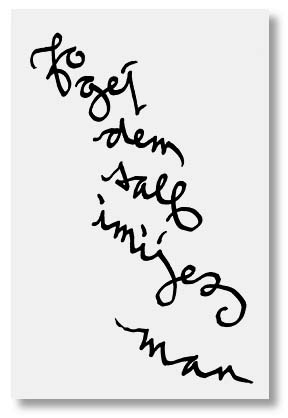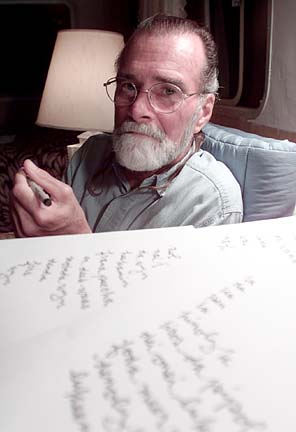

All things great and small, given enough study and interpretation and pedal-to-the-metal profundity, can become a venerated art, worthy of skull-scratching wonderment at the splendor of it all. Take -- for example -- pidgin English.
'Put your mind in neutral' is some
of the wisdom shared by bradajo,
a k a Joseph Hadley, among
the first to put pidgin to paperBy Burl Burlingame
bburlingame@starbulletin.comOh, try wait. Pidgin English is now considered a newly separate language among certain academics, and this story is in English, so we're not treating the subject in its proper context. Even the spelling is open-ended.

|
"And pidgin is an oral tradition, not a written one, so writing pidgin is always an approximation," points out artist Joseph Hadley. He's also known as Brother Joe, but goes, naturally, by "bradajo."Bradajo should know. About three decades ago, Hadley published a slim volume of pidgin poetry called "chalooookyu eensai," drawing on his boyhood memories of growing up on Kauai, and doubling his skill with ink-pen calligraphy with his onomatopoeic "approximations" of pidgin.
The book sold out lickety-split and has been in demand ever since in used-book shops. Readers sounded out Hadley's spellings, deciphered his phrasing, like secret agents using decoder rings, and unveiled Hadley's Zen-like aphorisms about the passages of time, culture and the environment.

|
Hadley -- known then primarily as the artist who would drape plaster-soaked sheets over people, making eerie, mysterious statues -- may have been simply an artist following his creative muse. But "chalooookyu eensai" was the first time pidgin was taken seriously enough on its own merits to rate as an accepted art form, or cultural phenomenon, or regional dialect, or whatevahs."chalooookyu eensai" made pidgin OK. "chalooookyu eensai" made pidgin something to be proud of. Kamehameha Schools teachers no longer yell at you for speak 'em.
Suddenly, there was an explosion of pidgin-related art, from da kine plays to da kine books to da kine literature like Bamboo Ridge and da kine comedy and commentary like Booga Booga. Li'dat.
And in the midst of this pidgin-orama, Hadley vanished.
"The usual story. Met a lady, got married, moved away, though I always knew I'd come back," sighed the artist, who, as Joe Hadley, taught art in the Vermont school system for a quarter-century.
Now, as bradajo, he's single, living in a bus in Waimanalo and making ends meet by tending coconut trees. And working again on his pidgin poetry, calligraphy and reading performances on CDs.
What brought him back fo' real was his 50th high-school reunion -- University Laboratory School, 1951 -- and it was in school on Kauai that Hadley became aware of the "shifting consciousness of change," as he shifted from pidgin dialect while talking to friends and neighbors to the different cadences and rhythms of standard English.

|
"Pidgin is definitely its own language. I'm not sure I want it analyzed too much -- that makes it lose its magic. It's like the great British sculptor Henry Moore, who, upon reading a biography of himself, stopped after Page 3 and declared, 'I don't want to know who I am.'"There's no way of understanding it; you just do it. Part of that is because pidgin is so oral, and the culture that produced it is oral. So, when I write it, I make a kind of calligraphic puzzle, to make it fun to figure out. But if you hear it, it all falls into place. That's why it's best on CD. I wouldn't want to put out the calligraphy without the spoken recordings as part of the package."
Hadley/bradajo has become a master reader of his own poems, becoming a kind of Zen storyteller. Many remember him from small-kid time. "Did I have a cult following," muses Hadley. "You must understand that the written form of pidgin is just a threshold for hearing it. It opens the opportunity to access the words.
"Even though I was on the mainland, I couldn't leave the pidgin. I'd read it to kids in study hall in Vermont, and they dug it, man. I grew up with it, and yeah, language does shape the personality."
Like runes from an ancient time, his calligraphic spellings bear little resemblance to much of the shorthand pidgin as written today.
"It's been a while since I was here, but ... time is an illusion, you know? We embrace time as a way of measuring how long it is before we die. We're in the process of transcending our cultural forgetfulness over time. We need reminders of where we've been and what we're doing, and I've been such a reminder."
Where: Native Books and Beautiful Things Bradajo readings
When: 11:30 a.m. tomorrow at 228 Merchant and 11:30 a.m. Saturday at Ward Warehouse
Admission: Free
Call: 599-5511 (downtown) or 596-8885 (Ward)
Click for online
calendars and events.